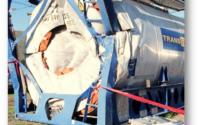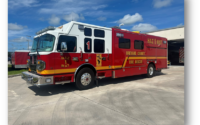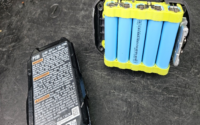Vapor Pressure – the Key to HazMat Response
Chris Hawley
When training to become a Hazardous Materials Technician, there are a lot of terms one must learn. In addition to all the terms there are a lot of concepts and response techniques to learn about. But out of all a hazardous material’s chemical and physical properties, vapor pressure is the key term and really is key to any response. In general, if a product has a high vapor pressure, it can be very dangerous to deal with. A material with a low vapor pressure has lesser concerns, as least related to vapor production. Vapor pressure has to do with the amount of vapors that are released from a liquid or a solid. The true definition is the pressure that is exerted on a closed container by the vapors coming from the liquid or solid. You can relate vapor pressure to the ability of a material to evaporate, as the material is not disappearing but moving to another state of matter.
Note: When gasoline evaporates it has not gone away, it has just changed its state of matter, and, has become more dangerous.

So, when we look at a risk-based response, we want to categorize chemicals into one or more of these categories: fire, corrosive, toxic, radioactive and oxidizers. Once we are armed with the risk category of a chemical present and we know the vapor pressure we can determine proper PPE, isolation distances and the severity of the incident. More information would certainly be helpful, but not necessary to act. Once we identify the risk and how aggressive a material is we can act. Using a suite of instruments and testing paper we can determine the risk category. An LEL sensor determines fire risk, pH paper indicates the corrosive risk, photoionization (PID) detector determines the toxic risk, a radiation pager/monitor determines the radiation risk and oxidizer (Ki) paper determines the oxidizer risk. These instruments/tests should be used on every response.
Pressures (vapor) are measured in several ways: millimeters of mercury (mm Hg), pounds per square inch (psi), torr, barr, kilopascals (kPa) and atmospheres (atm). The most common is millimeters of mercury, and when levels exceed 760 mm Hg the values are generally expressed in atmospheres (atm) Normal atmospheric conditions are listed here; materials with vapor pressures at or above these levels are usually gases.
760 mm Hg = 14.7 psi = 1 ATM = 1 Torr = 1 bar = 101.33 kPa
The typical temperature provided by references is 68°F (20°C). If a temperature is not provided, then it can be assumed to be 68°F (20°C). Temperature has a direct relationship with vapor pressure. The higher the temperature, the more vapors will be produced. Conversely, the lower the temperature, the lesser amount of vapors that will be produced. In situations such as a chemical spill in a building, the decrease in temperature can aid first responders by reducing the amount of vapors. HAZMAT responders can use elevated temperatures to remove a chemical from a building, and this tactic is used occasionally. Chemicals that have a significant vapor hazard are those more than 40 mm Hg as they are considered volatile. Chemicals with a vapor pressure of less than 40 mm Hg do not present an inhalation risk but they may present toxicity through skin absorption or ingestion. Chemicals with a vapor pressure above 40 mm Hg can be considered inhalation hazards in addition to any other route of exposure they may possess. When materials become vapors, they present more risk to us and are not easily controlled. The vapor pressure of water is ~ 20 mm Hg, and so we relate vapor pressures to this material. When a spilled material has a vapor pressure less than ~ 20 mm Hg, it will remain as a liquid longer than a given amount of water. If a material has a higher vapor pressure than water, then it will turn to a gas faster than the same amount of water. At 68°F (20°C) a cup of water will take at least a couple of days to evaporate. The same amount of gasoline will take a few hours to evaporate, which means that vapors (therefore an inhalation/fire risk) are being produced at a faster rate. Ethyl ether will only remain in liquid form for a few minutes as it has a high vapor pressure. Materials such as liquid chlorine, a gas that must be put under pressure to liquefy, will instantly turn to a gas upon release. On the other hand, sulfuric acid has a very low vapor pressure and only presents a contact hazard. It would take a long time for the acid to turn to the vapor form. Pure sodium hydroxide needs to be heated to 2534°F (1,390°C) for even a small amount of vapor to be released. These two materials present a minor vapor hazard, as they have extremely low vapor pressure. We know as responders that when something is heated to 2534°F (1,390°C), it is probably on fire and there are more issues to contend with other than a small amount of sodium hydroxide. The pesticide ethion has an even lower vapor pressure and will remain liquid for a long period of time, extending to months. The true hazard from ethion is from contact, not from inhalation.
Example Vapor Pressures
Ethion = 0.0000015 mm Hg
Sulfuric acid = 0.001 mm Hg
Sodium hydroxide = 1.5 mm Hg
Sarin nerve agent = 2. 9 mm Hg
Diesel fuel = 5 mm Hg
Water = ~ 20 mm Hg
Isopropyl alcohol = 33 mm Hg
Hydrochloric acid = 40.5 mm Hg
Acetone = 180 mm Hg
Gasoline = 300 mm Hg
Ethyl ether = 440 mm Hg
Chlorine = 6.8 ATM (5,168 mm Hg)
Propane = 8.4 ATM (6,384 mm Hg)
Anhydrous ammonia = 8.5 ATM (6,460 mm Hg)
Vapor pressure is the force that is coming off a material and is related to another term, volatility. In many cases these terms are used interchangeably, which is a mistake. Volatility is the weight of vapors that are coming from the material. Both vapor pressure and volatility are interrelated, but they are not the same thing. In most cases the relationship is consistent, as most high vapor pressure materials also have high volatility, but this does not hold true for all materials. Xylene, for example, has an extremely low vapor pressure (9 mm Hg) but is a flammable liquid that evaporates quickly. There are two reasons for this: high volatility (39,012 mg/M3) and the makeup of the molecular structure. The chemical structure is a benzene ring which is a major factor in its being a flammable liquid.
In the HAZMAT world there are many gray areas, and we just navigated through one, as this is an example of how vapor pressure offers some information on how to protect your safety. We consider materials to be of concern for inhalation hazards to have a vapor pressure more than 40 mm Hg. It is also at this point that we can increase the amount of risk a chemical present. Chemicals with a vapor pressure more than 40 mm Hg have greater potential to move away from the immediate site of the event, can be flammable, or can require increased isolation and evacuation distances. A chemical that has a vapor pressure of less than 40 mm Hg usually can only create harm through touch or ingestion. They may be extremely toxic or corrosive, but the mechanism of harm is through touch or ingestion.
When you see vapor pressures expressed in atmospheres that material can travel for miles. Chlorine as an example can travel for 23 miles and wreak havoc all along the way. Anyone caught in that vapor cloud is most likely going to be seriously impacted, in other words be killed. While an incident that involves sulfuric acid only requires a very small isolation distance as it will not have any downwind effects. The edge of the isolation zone could be 10 feet away from the edge of the spill. You don’t need any written information about a spill, if you are walking towards a tractor trailer with your instruments and your pH paper turns red when you are 100 feet (33 m) away you have a high vapor pressure acid leaking, and it is most likely hydrochloric acid. If you have another scenario and you have to walk up to the back of the truck and you sample the liquid coming from the trailer and the liquid turns the pH paper red it is a low vapor pressure acid, most likely sulfuric. Think about another scenario as you walk towards the truck your LEL sensor indicates 8%. This means there is a high vapor pressure flammable liquid leaking or a flammable gas cylinder leaking. The further away your instrument shows a flammable reading the higher the vapor pressure of the material.
There is much more we could discuss about vapor pressure and a risk-based response but hopefully you have a better appreciation of vapor pressure. It really is the key to understanding your risk at an incident. If we were playing a game and you were only giving me one clue, I would want the vapor pressure of the material. With my instruments I can figure out the risk category. Once I have that information I can dress appropriately, isolate effectively, and determine the severity of the incident. At a real incident I can gather this information in less than 5 minutes and be working to resolve the incident. How long does it take you to get set up and figure things out?




